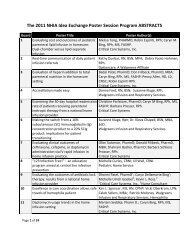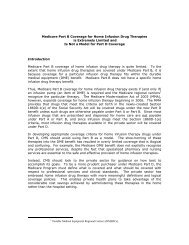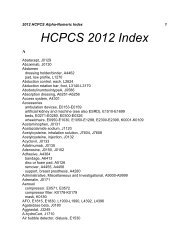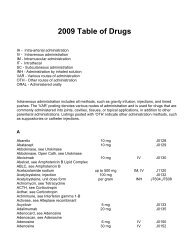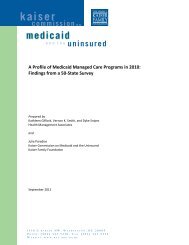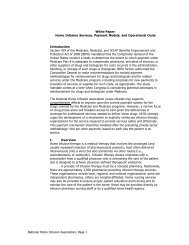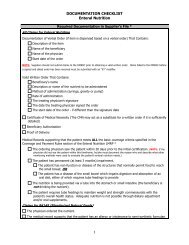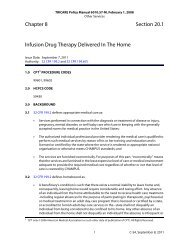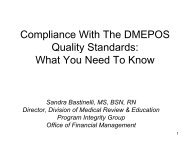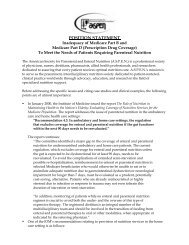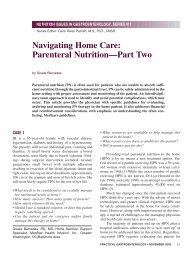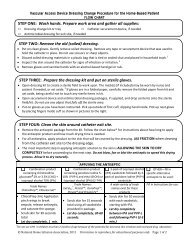IgG Therapy for the Home-Based Patient: Administration and ... - NHIA
IgG Therapy for the Home-Based Patient: Administration and ... - NHIA
IgG Therapy for the Home-Based Patient: Administration and ... - NHIA
You also want an ePaper? Increase the reach of your titles
YUMPU automatically turns print PDFs into web optimized ePapers that Google loves.
tion <strong>and</strong> improved indices of wellbeing compared to <strong>the</strong><br />
group treated with traditional <strong>IgG</strong> doses. 18<br />
Many clinicians now believe that <strong>the</strong> mean dose adjustment<br />
coefficient <strong>and</strong> <strong>the</strong> mean trough level ratio should only<br />
be used as rough guides in dosing. As additional outcomes,<br />
such as slowing of disease progression, frequency of infection,<br />
days of work/school missed, etc., are considered, experienced<br />
clinicians are tending toward higher doses while<br />
relying on patient monitoring to adjust <strong>the</strong>rapeutic levels of<br />
<strong>IgG</strong>. In a survey of immunologists, those with more indepth<br />
experience—more than 10% of <strong>the</strong>ir practice was devoted<br />
to PID patients—were significantly more likely to target<br />
higher serum levels (above 750 mg/dL); whereas those with<br />
fewer than 10% PID patients usually targeted lower serum<br />
levels (500750 mg/dL). 20<br />
<strong>Home</strong> infusion <strong>and</strong> specialty pharmacy providers can play a<br />
critical role in patient monitoring by collecting supporting documentation<br />
on <strong>the</strong> <strong>the</strong>rapeutic effectiveness of <strong>IgG</strong> regimens<br />
from a variety of perspectives, including: response to <strong>the</strong>rapy,<br />
abatement of symptoms, <strong>and</strong> quality of life. This data provides<br />
meaningful feedback <strong>for</strong> physicians working to find each patient’s<br />
dosing “sweet spot,” <strong>and</strong> also aids in building a case <strong>for</strong><br />
reimbursement, especially if <strong>the</strong> patient’s recommended<br />
dosage falls outside <strong>the</strong> “normal” payer guidelines.<br />
SCIG <strong>Administration</strong><br />
SCIG administration presents some unique challenges from<br />
a clinical perspective. With <strong>the</strong> medication itself, volume <strong>and</strong><br />
viscosity are key factors in care planning. The <strong>the</strong>rapy also<br />
involves a different—but similar—set of supplies than those<br />
used to administer IVIG.<br />
For example, <strong>the</strong> home infusion/specialty pharmacy care<br />
team should map out a regimen based on <strong>the</strong> prescribed dosing<br />
parameters. They need to consider <strong>the</strong> individual patient<br />
<strong>and</strong> total volume of <strong>the</strong>rapy to determine <strong>the</strong> number of fractionations<br />
<strong>and</strong> sites to be infused with each administration.<br />
As a rule of thumb, infusions should last 4550 minutes, <strong>and</strong><br />
should not be longer than 90 minutes. Generally, no more<br />
than 15 mL should be administered in any one site. In order<br />
to limit swelling, a rate of 20 mL/hour is suggested <strong>for</strong> rapid<br />
infusions; 4 mL/hour is suggested <strong>for</strong> longer infusions. 11<br />
SCIG is viscous—much more so than <strong>the</strong> sterile water used<br />
to calibrate typical IV administration rates—so tubing sets<br />
need to be adjusted to achieve <strong>the</strong> desired rate. For example,<br />
pumps <strong>and</strong> tubing may need to be set at 600 mL/hr to deliver<br />
20 mL/hr to <strong>the</strong> patient. There are several infusion pumps<br />
<strong>and</strong> needles specifically designed <strong>for</strong> SC administration—<br />
some pumps use only proprietary sets. Many pump manufacturers<br />
offer sample supply lists online to prompt pharmacy<br />
<strong>IgG</strong> <strong>Therapy</strong> <strong>for</strong> <strong>the</strong> <strong>Home</strong><strong>Based</strong> <strong>Patient</strong>: <strong>Administration</strong> <strong>and</strong> Delivery Method Considerations 5



